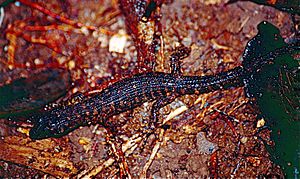Concinnia queenslandiae facts for kids
Quick facts for kids Concinnia queenslandiae |
|
|---|---|
 |
|
| Conservation status | |
| Scientific classification | |
| Genus: |
Concinnia
|
| Species: |
queenslandiae
|
| Synonyms | |
|
|
The prickly skink, also called the prickly forest skink (Concinnia queenslandiae), is a special type of skink. It lives only in the rainforests of the Wet Tropics of Queensland World Heritage Area in north-eastern Australia.
Most small skinks have smooth scales. But the prickly skink is different! It has rough, ridged, and pointed scales. These unique scales might help it live in its rainy home. They could also help it hide among rotting logs or leaves on the forest floor.
Contents
About the Prickly Skink
The prickly skink belongs to a large group of skinks found in Australia. Scientists have studied its genes to understand where it fits in the skink family tree. It was once in its own group, but now it's part of the Concinnia genus.
Where Does the Prickly Skink Live?
This skink is a rainforest specialist. It lives only in forests with thick tree canopies and lots of rain. You can find it in tropical rainforests near the coast and in mountain forests.
Inside these rainforests, prickly skinks like to live in rotting logs and leaf litter. Even though there can be many of them in one area, they are hard to spot. You usually have to search for them! Their home is very stable, with not much change in weather throughout the year.
Life Cycle and Reproduction
Prickly skinks are ovoviviparous. This means the mother carries her eggs inside her body until they hatch. Then, she gives birth to live young. Even though they live in a stable climate, they have babies at a specific time of year. Females usually give birth to 2 to 5 young between February and April.
Young skinks grow to about 50 millimeters (2 inches) long before they can have their own babies. They can grow up to 85 millimeters (3.3 inches) long. Males and females look similar in size and shape. Scientists believe they live about 5 years when they start having babies and can live up to 10 years in total.
Unlike many skinks, the prickly skink can make sounds! People have heard their high-pitched calls in the wild and when they are kept by scientists. They often make these sounds when handled or when females are fighting.
Studying Prickly Skink Populations
Large areas of the Australian Wet Tropics, like the Atherton Tableland, were cleared for farms between 1940 and 1990. This left many small patches of rainforest surrounded by open fields. The prickly skink is common in these areas. Because of this, it has become a good animal to study how losing habitat affects animals. Scientists look at how habitat changes affect their genes and how they move around.
Genetic Differences in Skink Groups
Studies have shown that prickly skinks from the northern and southern parts of the Wet Tropics are genetically different. These two areas are connected by a narrow strip of rainforest called the Black Mountain Corridor. However, scientists think that during past ice ages, these rainforests were separated by dry land.
The big genetic differences suggest that these groups have been separated for a very long time, maybe over five million years! This means they might even be different species. Further studies also found genetic differences within the southern group, especially between skinks living near the Bellenden Ker Range and those in other areas.
How Habitat Changes Affect Skinks
Scientists have looked at how clearing forests affects prickly skinks. They found that skinks in continuous forests were more abundant than those in small, isolated patches. Skinks in smaller patches were also generally smaller in size.
Studies show that prickly skinks live in densities of about 65 to 136 individuals per hectare (about 2.5 acres). They don't move very far, usually staying within a few hundred meters. Young skinks often stay with their parents for a year or two before moving to other logs.


